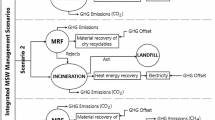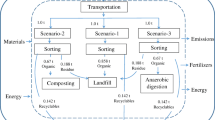Abstract
Purpose
Large stocks of many kinds of zinc smelting solid waste have been generated; moreover, the disposal process consumes high amounts of energy and takes low output rate of metal resources, which seriously endangers regional ecological environment and human health. The purpose of this study is to compare the environmental impact of the production process of zinc in the “traditional smelting mode” and the “solid waste synergism mode”; to further investigate the efficiency of material utilization, resource recovery, and carbon reduction in the two modes; and to provide expectations and suggestions for reducing environmental risks.
Methods
This study focuses on a typical zinc smelting enterprise in China, with the help of SimaPro 9.0 software, to compare and analyze the differences in direct, indirect, and overall environmental impacts between the “traditional mode” and the “synergism mode,” with a focus on the production and waste disposal processes. At the same time, the potential environmental burdens and carbon emission levels that could be reduced by solid waste co-processing are further investigated.
Results and discussion
The results show that although the environmental burden of “the acid production from flue gas” is slightly higher in the synergism mode than the traditional mode, the environmental burden caused by all other processes is reduced by more than 20% and the energy consumption is reduced by 20.6–21.4% with the synergism mode. For the waste residue disposal process, the recovery rate of valuable components, such as Zn, Cd, and In, increased approximately 30% compared with the traditional mode, and the total environmental burden is reduced nearly onefold. In addition, the “concentrate + slag” smelting method has reduced zinc concentrate consumption per unit of zinc product by 26.7% and cut carbon emissions by 57.3%.
Conclusions
Solid waste co-processing can effectively reduce the stockpiling of waste residues and perform secondary recovery of metal resources. Enhancing the solid waste collaborative utilization level can greatly reduce environmental risks and realize resource recycling for nonferrous industry.










Similar content being viewed by others
Data availability
All data generated or analyzed during this study are included in this published article and its supplementary material.
Abbreviations
- GWP:
-
Global warming
- HOFP:
-
Ozone formation and human health
- PMFP:
-
Fine particulate matter formation
- TAP:
-
Terrestrial acidification
- FEP:
-
Freshwater eutrophication
- MEP:
-
Marine eutrophication
- HTPc:
-
Human carcinogenic toxicity
- HTPnc:
-
Human non-carcinogenic toxicity
- SOP:
-
Mineral resource scarcity
- FFP:
-
Fossil resource scarcity
References
Alistair JD, Binks SP, Gediga J (2016) Lead industry life cycle studies: environmental impact and life cycle assessment of lead battery and architectural sheet production. Int J Life Cycle Assess 21(11):1624–1636. https://doi.org/10.1007/s11367-015-1021-5
Brunner PH, Rechberger H (2015) Waste to energy – key element for sustainable waste management. Waste Manag 37:3–12. https://doi.org/10.1016/j.wasman.2014.02.003
Chen JJ, Wang ZH, Wu YF, Li LQ, Li B, Pan DA, Zuo TY (2019) Environmental benefits of secondary copper from primary copper based on life cycle assessment in China. Resour Conserv Recycl 146:35–44. https://doi.org/10.1016/j.resconrec.2019.03.020
China Statistical Yearbook (2015–2020) http://www.stats.gov.cn/tjsj/ndsj. Accessed 13 Sept 2021
China Statistical Yearbook (2020) http://www.stats.gov.cn/tjsj/ndsj/2020/indexch.htm. Accessed 15 Aug 2021
Çoruh S, Elevli S, Ergun ON, Demir G (2013) Assessment of leaching characteristics of heavy metals from industrial leach waste. Int J Miner Process 123:165–171. https://doi.org/10.1016/j.minpro.2013.06.005
Ecoinvent centre (2015) Swiss Centre for Life Cycle Inventories. Zurich, Switzerland. https://v34.ecoquery.ecoinvent.org/Account/LogOn?ReturnUrl%C2%BC%2fHome%2fIndex. Accessed 30 Nov 2021
Farjana SH, Nazmul Huda MA, Mahmud P (2019) Life cycle analysis of copper-gold-lead-silver-zinc beneficiation process. Sci Total Environ 659:41–52. https://doi.org/10.1016/j.scitotenv.2018.12.318
Fellner J, Lederer J, Purgar A, Winterstetter A, Rechberger H, Winter F, Laner D (2015) Evaluation of resource recovery from waste incineration residues – the case of zinc. Waste Manag 37:95–103. https://doi.org/10.1016/j.wasman.2014.10.010
Gharabaghi M, Irannajad M, Azadmehr AR (2012) Leaching behavior of cadmium from hazardous waste. Sep Purif Technol 86:9–18. https://doi.org/10.1016/j.seppur.2011.10.014
Gu MY, Zhong YW, Wang LJ, Guo ZC (2021) Separation of heavy metals from hazardous lead slag by carbothermic reduction and thermal volatilization: effect of phase transformation on Sn, Pb, Zn Removal. Process Saf Environ Prot 156:330–339. https://doi.org/10.1016/j.psep.2021.10.027
Hong JM, Yu ZH, Shi WX, Hong JL, Qi CC, Ye LP (2017) Life cycle environmental and economic assessment of lead refining in China. Int J Life Cycle Assess 22:909–918. https://doi.org/10.1007/s11367-016-1209-3
Huang YK, Zhang ZF, Cao YJ, Han GH, Peng WJ, Zhu XF, Zhang TA, Dou ZH (2020) Overview of cobalt resources and comprehensive analysis of cobalt recovery from zinc plant purification residue- a review. Hydrometallurgy 193:105327–105339. https://doi.org/10.1016/j.hydromet.2020.105327
IESLUN (2009) Institute of Environmental Science in Leiden University of Netherland. Leiden, Nederland. https://www.universiteitleiden.nl/en/research/research-projects/science/cml-ReCiPe. Accessed 30 Nov 2021
ISO (International Standard Organization) (2006a) Environmental managements - life cycle assessments - principles and framework (ISO 14040–2006). International Organization for Standardization, Geneva. https://www.iso.org/standard/37456.html. Accessed 22 Sept 2021
ISO (International Standard Organization) (2006b) Environmental managements - life cycle assessments -requirements and guidelines (ISO 14044–2006). International Organization for Standardization, Geneva. https://www.iso.org/standard/38498.html. Accessed 22 Sept 2021
Kaya M, Hussaini S, Kursunoglu S (2020) Critical review on secondary zinc resources and their recycling technologies. Hydrometallurgy 195:105362–105395. https://doi.org/10.1016/j.hydromet.2020.105362
Lei K, Giubilato E, Critto A, Pan HQ, Lin CY (2016) Contamination and human health risk of lead in soils around lead/zinc smelting areas in China. Environ Sci Pollut Res 23(13):13128–13136. https://doi.org/10.1007/s11356-016-6473-z
Liao Y, Liu W, Xu HM, Hong QY, Wang YL, Qu Z, Yan NQ (2020) Zinc concentrate internal circulation technology for elemental mercury recovery from zinc smelting flue gas. Fuel 280:118566–118573. https://doi.org/10.1016/j.fuel.2020.118566
Lin BQ, Zhang GL (2013) Estimates of electricity saving potential in Chinese nonferrous metals industry. Energy Policy 60:558–568. https://doi.org/10.1016/j.enpol.2013.05.051
Miah JH, Koh SCL, Stone D (2017) A hybridised framework combining integrated methods for environmental life cycle assessment and life cycle costing. J Clean Prod 168:846–866. https://doi.org/10.1016/j.jclepro.2017.08.187
Najimi M, Sobhani J, Pourkhorshidi AR (2011) Durability of copper slag contained concrete exposed to sulfate attack. Constr Build Mater 25:1895–1905. https://doi.org/10.1016/j.conbuildmat.2010.11.067
Norgate TE, Jahanshahi S, Rankin WJ (2007) Assessing the environmental impact of metal production processes. J Clean Prod 15(8):838–848. https://doi.org/10.1016/j.jclepro.2006.06.018
NRDC (2016) National Development and Reform Commission. http://ghs.ndrc.gov.cn/ghwb/gjjgh/201706/t20170614_850909.html. Accessed 30 Oct 2021
Nuss P, Eckelman MJ (2014) Life cycle assessment of metals: a scientific synthesis. PLoS ONE 9(7):101298–101310. https://doi.org/10.1371/journal.pone.0101298
Qi CC, Ye LP, Ma XT, Yang DL, Hong JL (2017) Life cycle assessment of the hydrometallurgical zinc production chain in China. J Clean Prod 156:451–458. https://doi.org/10.1016/j.jclepro.2017.04.084
Qin QD, Jiao YM, Gan XB, Liu Y (2020) Environmental efficiency and market segmentation: an empirical analysis of China’s thermal power industry. J Clean Prod 242:118560–118570. https://doi.org/10.1016/j.jclepro.2019.118560
Rubin RS, Soares MA, de Castro D, Brandão VS, Ometto AR (2014) Utilization of life cycle assessment methodology to compare two strategies for recovery of copper from printed circuit board scrap. J Clean Prod 64:297–305. https://doi.org/10.1016/j.jclepro.2013.07.051
Stewart M, Petrie J (2006) A process systems approach to life cycle inventories for minerals: South African and Australian case studies. J Clean Prod 14(12):1042–1056. https://doi.org/10.1016/j.jclepro.2004.08.008
Shang WX, Peng ZW, Huang YW, Gu FQ, Zhang J, Tang HM, Yang L, Tian WG, Rao MJ, Li GH, Jiang T (2021) Production of glass-ceramics from metallurgical slags. J Clean Prod 317:128220–128234. https://doi.org/10.1016/J.JCLEPRO.2021.128220
Shi CJ, Meyer C, Behnood A (2008) Utilization of copper slag in cement and concrete. Resour Conserv Recycl 52:1115–1120. https://doi.org/10.1016/j.resconrec.2008.06.008
Song SL, Sun W, Wang L, Liu RQ, Han HS, Hu YH, Yang Y (2019) Recovery of cobalt and zinc from the leaching solution of zinc smelting slag. J Environ Chem Eng 7(1):102777–102786. https://doi.org/10.1016/j.jece.2018.11.022
Statistical bulletin of China’s national economic and social development in 2020 (2021) http://www.stats.gov.cn/tjsj/zxfb/202102/t20210227_1814154.html. Accessed 20 Aug 2021
Tang L, Tang CB, **ao J, Zeng P, Tang MT, Wang ZA, Zhang ZH (2019) A cleaner process for lead recovery from lead-containing hazardous solid waste and zinc leaching residue via reducing-matting smelting. J Clean Prod 241:118328–118336. https://doi.org/10.1016/j.jclepro.2019.118328
Van Genderen E, Wildnauer M, Santero N, Sidi N (2016) A global life cycle assessment for primary zinc production. Int J Life Cycle Assess 21(11):1580–1593. https://doi.org/10.1007/s11367-016-1131-8
Wang SF, Zhang DN, Li XL, Zhang GQ, Wang Y, Wang X, Gomez MA, Jia YF (2018) Arsenic associated with gypsum produced from Fe(III)-As(V) coprecipitation: Implications for the stability of industrial As-bearing waste. J Hazard Mater 360:311–318. https://doi.org/10.1016/j.jhazmat.2018.08.017
Wang SX, Song JX, Li GH, Wu Y, Zhang L, Wan Q, Streets DG, Chin CK, Hao JM (2010) Estimating mercury emissions from a zinc smelter in relation to China’s mercury control policies. Environ Pollut 158(10):3347–3353. https://doi.org/10.1016/j.envpol.2010.07.032
Wu QS, Wu Y, Tong WH, Ma HG (2018) Utilization of nickel slag as raw material in the production of Portland cement for road construction. Constr Build Mater 193:426–434. https://doi.org/10.1016/j.conbuildmat.2018.10.109
Yu X, Sekhari A, Nongaillard A, Bouras A, Yu SR (2014) A sensitivity analysis approach to identify key environmental performance factors. Math Probl Eng 2014:565–578. https://doi.org/10.1155/2014/918795
Zhang GZ, Liu DY, He XH, Yu DY, Pu MJ (2017) Acid rain in Jiangsu province, eastern China: tempo-spatial variations features and analysis. Atmospheric Pollut Res 8(6):1031–1043. https://doi.org/10.1016/j.apr.2017.02.001
Funding
This study is funded by the National key Research and Development Program (2018YFC1903305), the Science and Technology Project for the Construction of Ecological Civilization in Beautiful China (XDA23030303), and the Youth Science Foundation Project of the National Natural Science Foundation of China (52100215).
Author information
Authors and Affiliations
Corresponding author
Ethics declarations
Conflict of interest
The authors declare no competing interests.
Additional information
Communicated by Andrea J Russell-Vaccari
Publisher's Note
Springer Nature remains neutral with regard to jurisdictional claims in published maps and institutional affiliations.
Supplementary Information
Below is the link to the electronic supplementary material.
Rights and permissions
Springer Nature or its licensor holds exclusive rights to this article under a publishing agreement with the author(s) or other rightsholder(s); author self-archiving of the accepted manuscript version of this article is solely governed by the terms of such publishing agreement and applicable law.
About this article
Cite this article
Liu, WN., Shi, Y., Zhang, CM. et al. Environmental impact of typical zinc smelting that implements solid waste collaborative utilization in China. Int J Life Cycle Assess 27, 1316–1333 (2022). https://doi.org/10.1007/s11367-022-02100-6
Received:
Accepted:
Published:
Issue Date:
DOI: https://doi.org/10.1007/s11367-022-02100-6




